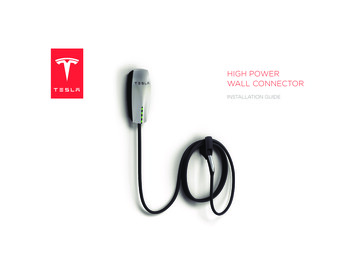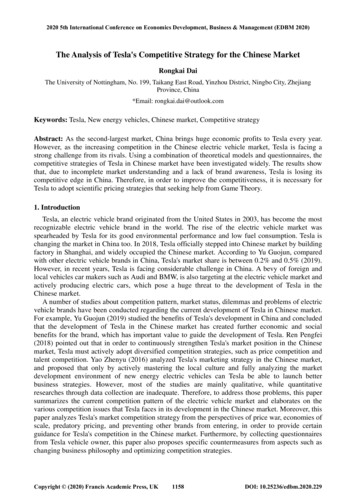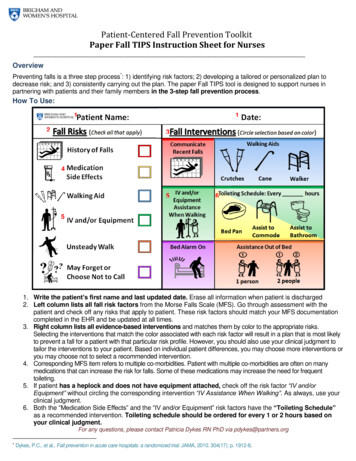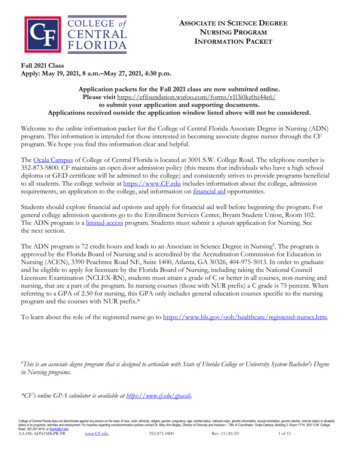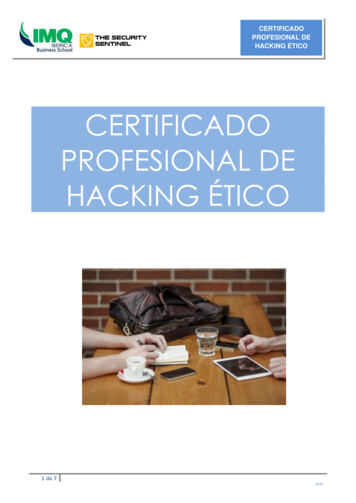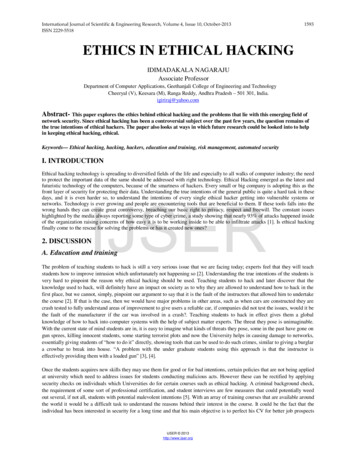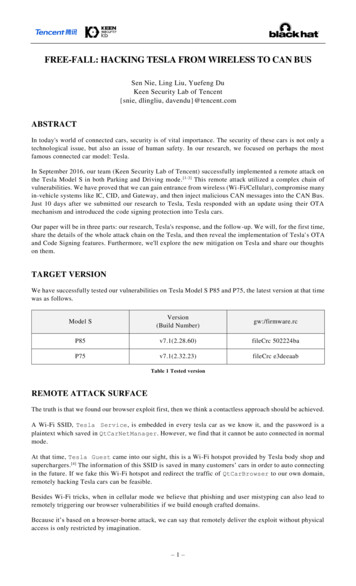
Transcription
FREE-FALL: HACKING TESLA FROM WIRELESS TO CAN BUSSen Nie, Ling Liu, Yuefeng DuKeen Security Lab of Tencent{snie, dlingliu, davendu}@tencent.comABSTRACTIn today's world of connected cars, security is of vital importance. The security of these cars is not only atechnological issue, but also an issue of human safety. In our research, we focused on perhaps the mostfamous connected car model: Tesla.In September 2016, our team (Keen Security Lab of Tencent) successfully implemented a remote attack onthe Tesla Model S in both Parking and Driving mode. [1-3] This remote attack utilized a complex chain ofvulnerabilities. We have proved that we can gain entrance from wireless (Wi -Fi/Cellular), compromise manyin-vehicle systems like IC, CID, and Gateway, and then inject malicious CAN messages into the CAN Bus.Just 10 days after we submitted our research to Tesla, Tesla responded with an update using their OTAmechanism and introduced the code signing protection into Tesla cars.Our paper will be in three parts: our research, Tesla's response, and the follow-up. We will, for the first time,share the details of the whole attack chain on the Tesla, and then reveal the implementation of Tesla' s OTAand Code Signing features. Furthermore, we'll explore the new mitigation on Tesla and share our thoughtson them.TARGET VERSIONWe have successfully tested our vulnerabilities on Tesla Model S P85 and P75, the latest version at that timewas as follows.Model SVersion(Build Number)gw:/firmware.rcP85v7.1(2.28.60)fileCrc 502224baP75v7.1(2.32.23)fileCrc e3deeaabTable 1 Tested versionREMOTE ATTACK SURFACEThe truth is that we found our browser exploit first, then we think a contactless approach should be achieved.A Wi-Fi SSID, Tesla Service , is embedded in every tesla car as we know it, and the password is aplaintext which saved in QtCarNetManager . However, we find that it cannot be auto connected in normalmode.At that time, Tesla Guest came into our sight, this is a Wi-Fi hotspot provided by Tesla body shop andsuperchargers. [4] The information of this SSID is saved in many customers’ cars in order to auto connectingin the future. If we fake this Wi-Fi hotspot and redirect the traffic of QtCarBrowser to our own domain,remotely hacking Tesla cars can be feasible.Besides Wi-Fi tricks, when in cellular mode we believe that phishing and user mistyping can also lead toremotely triggering our browser vulnerabilities if we build enough crafted domains.Because it’s based on a browser-borne attack, we can say that remotely deliver the exploit without physicalaccess is only restricted by imagination.–1–
BROWSER HACKINGSince the User Agent of Tesla web browser is "Mozilla/5.0 (X11; Linux) AppleWebKit/534.34(KHTML, like Gecko) QtCarBrowser Safari/534.34 ", it can be deduced that the version ofQtWebkit is around 2.2.x. In such old version, there are many vulnerabilities in QtWebkit. Our exploitutilizes two vulnerabilities to achieve arbitrary code execution.The first vulnerability exists in function JSArray::sort() . This function will be called when the methodfunction sort() of an array be called in JavaScript code. The function JASrray::sort() mainly dothree things:1. Copy elements from array this- m storage.m vector into an AVLTree structure.2. Call the compareFunction function specified by the caller.3. Copy the sorted elements from AVLTree back into this- m storage.m vector.void JSArray::sort(ExecState* exec, JSValue compareFunction,CallType callType, const CallData& callData){checkConsistency();ArrayStorage* storage m storage;// .// Copy the values back into m storage.AVLTree AVLTreeAbstractorForArrayCompare, 44 ::Iteratoriter;iter.start iter least(tree);JSGlobalData& globalData exec- globalData();for (unsigned i 0; i numDefined; i) {storage- m vector[i].set(globalData, this,tree.abstractor().m nodes[*iter].value); iter;}.}Table 2 Code Snippet of the Vulnerable FunctionThe vulnerability is that if compareFunction is JSArray::shiftCount() , the length of them vector will be changed, also the entire m vector structure will be shifted to another place. However,the local variable pointer storage still points to the old location, result in memory corruption.When a non-shifted array called sort() to trigger this issue, the variable map reference by the local pointerstorage always overlaps with the variable m length of the new storage structure, result in crash. Wesolved this problem by sort() a pre-shifted array and set compareFunctiontoJSArray::unshiftCount(), so variable map can be overlapped with a JSValue structure inm vector. The JSValue structure has two members, payload and tag. Precisely, map is overlappingwith the field payload. If we set the overlapped element to an integer zero, tag will be 0xffffffff whichmeans the type of this JSValue is int32, the payload will be 0, that is map will be 0.void JSArray::sort(ExecState* exec, JSValue compareFunction,CallType callType, const CallData& callData){checkConsistency();ArrayStorage* storage m storage;.if (SparseArrayValueMap* map storage- m sparseValueMap) {newUsedVectorLength map- size();//crash here.}}Table 3 Crash Point in JSArray::sort()–2–
In the function JSArray::sort() . The local pointer storage used in two places aftercompareFunction be called. In the second place, new length will be write back into original storagestructure. Since m numValuesInVector can be overlapped with the tag of JSValue structure , we canchange tag to make a type confusion. When changed the tag from CellTag to a value of length, wechanged the type to double. As a result, we can get a JSCell address from this double value.void JSArray::sort(ExecState* exec, JSValue compareFunction,CallType callType, const CallData& callData){.storage- m numValuesInVector newUsedVectorLength;.}Table 4 Code About Leaking JSCell AddressIn the first place, local pointer storage is used for copying sorted elements back into original storagestructure. After some unshift() in compareFunction , we have the chance to overwrite them allocBase of the storage structure. In function JSArray::unshiftCount() , when the whole premalloced buffer cannot hold all the elements, JSArray::unshiftCount() will callincreaseVectorPrefixLength() to fastMalloc() a bigger buffer and free the old one. Since wecorrupt the value of m allocBase , we could fastFree() arbitrary address.The second vulnerability is CVE-2011-3928 founded by KeenTeam, which could be used for leakingmemory. The POC is simple. script if (window.addEventListener) {window.addEventListener('load', func, false);}function func(){e e,true);} /script table id "t1" td xht:input Table 5 POC of CVE-2011-3928If the parameter of function importNode() is a node created as "xht:input", a type confusion bug willbe triggered when the function copyNonAttributeProperties() doing static cast . The size ofsource type Element is 0x34 and the size of destination type HTMLInputElement is 0x7c .void HTMLInputElement::copyNonAttributeProperties(const Element*source){const HTMLInputElement* sourceElement static cast constHTMLInputElement* (source);m data.setValue(sourceElement- m data.value());setChecked(sourceElement- m isChecked);m reflectsCheckedAttribute sourceElement m reflectsCheckedAttribute;m isIndeterminate sourceElement- m opyNonAttributeProperties(source);}Table 6 Vulnerability in CVE-2011-3928We try to allocate many Element structures together on heap. After static cast, the member m dataof HTMLInputElement will overlap with the pointer m next of Element. Also, we inserted the second–3–
and the third Element structure into same label together as children, m next and m data both point tothe third Element structure.Since m data points to a StringImpl structure and this StringImpl structure is overlapped with anElement structure. The member m data of StringImpl structure always be a fixed value 1 andm length of StringImpl structure always be a pointer which is big enough for us to read the wholememory.Finally, we can chain these together to achieve arbitrary code execution:1. Leak a JSCell address of a Uint32Array structure by utilizing the vulnerability inJSArray::sort() .2. Get the address of the class structure of this Uint32Array by utilizing CVE-2011-3928.3. FastFree() this address by utilizing the vulnerability in JSArray::sort().4. Define a new Uint32Array to achieve arbitrary address write.5. Insert a JavaScript function into an array.6. Leak the JSCell address of this JavaScript function.7. Get the address of the JIT memory from JSCell address and JSC::ExecutableBase structure.8. Write shellcode to JIT memory and execute this JavaScript function.We must say it is difficult to develop a feasible and stable exploit without any debugging method and withoutQtCarBrowser binary from Tesla CID. However, it was deserved as the final exploit gave us the first shellfrom Tesla CID and the shell is very stable.LOCAL PRIVILEGE ESCALATIONThough we got a remote shell based on our browser hacking, it’s also impossible to get arbitrary permissionbecause of AppArmor. We need another vulnerability to escape from AppArmor and get a higher privilegethan browser’s process context.It seems that the Linux kernel version of CID is very old, there is nearly no exploiting mitigations on Linuxkernel 2.6.36.Figure 1 CID Linux Kernel VersionWe also find some BSPs of Tegra on https://developer.nvidia.com/linux-tegra-archives. After some research,we were shocked that the (in)famous ARM Linux vulnerability CVE -2013-6282(Missing access checks input user/get user kernel API) is still exists on Tesla.–4–
Figure 2 Patch of CVE-2013-6282 from linux.orgBased on the CVE-2013-6282, we can get the arbitrary read/write in kernel context, it is pretty easyto write an exploit. In our exploit, firstly we patched setresuid() syscall to get the root privilege,and then we invoked reset security ops() to disable AppArmor . It’s obviously that we’re nowin god mode.UNAUTHORIZED ACCESS OF THE EMBEDDED SYSTEMSWe have known that there are three more important individual embedded systems on Tesla besides CID,they are IC, Parrot and Gateway. Getting root access on these three systems via remote attack sounds prettyattractive to us. Several defects on network design and lack of strong cipher protection contributepossibilities of these targets.Figure 3 Important Devices of In-vehicle Network–5–
ICAfter we got root privilege in CID, it is amazing that researchers could ssh into IC as root without anypassword. We have certitude that the SSH key of root user has been stored in ".ssh" folder, so that it's easyto use following command:ssh root@icto get root access on IC.Additionally, gaining mutual access between CID and IC is also possible. Upon past researches, we haveknown that CID contains a key rotation scheme that receives a random new token of user tesla1 from themothership every 24 hours. However, CID would set the key in IC's file system in plaintext, which meanseven if we could only get access to IC, we are also able to ssh to CID and get root privilege.However, after received our report, Tesla fixed this issue, now it’s forbidden to access CID from IC.ParrotThrough scanning the opening ports on Parrot, we found port 23 is opened for Telnet as usual. A fatalvulnerability is that the Telnet is anonymous, which contributes access of Parrot. An easy commandnc parrot 23makes parrot under researchers' control.GatewayGateway looks like much safer than IC and Parrot,which leaves two main challenges for researchers.Finding out the shell entry is the first step, while the binary file gw-diag provides several clues. gw-diagfile is designed for diagnosing Gateway and offers a special approach to call some functions on Gatewaythrough port 3500. Reversing this binary file helps us find out a function named ENABLE SHELL, lightingthe possibility of gaining shell. After many-times trials, commandprintf "\x12\x01" socat - udp:gw:3500would wake up Gateway’s backdoor on port 23. Thus, we found the shell entry of Gateway.The second step is pointing out the security token of the backdoor. Developers specially leave the tokencheck for Gateway, leading more challengeable to attack than Parrot. Nonetheless, this security token isstatic and written in the firmware of Gateway. Researchers could easily reverse the firmware to gain thetoken:Figure 4 Console Password Verification of the Gateway–6–
From the above screenshot of function shellTask() in IDA, we could find the static token of GatewayTelnet is 1q3e5t7u, an easily-remember regular string on keyboard. Until now, we could get full access tothe Gateway.Figure 5 Enter the Gateway Shell with the PasswordECU PROGRAMMING ON TESLABy disassemble the CID unit, we found the gateway ECU (GTW) is also in the box. Further analysis founda SD Card without any protection is directly connected to the GTW. By examining the FAT FS on this card,we found several debug and upgrade-related files:Figure 6 Files on the SD CardAfter a fast review of those log files, we noticed udsdebug.log . We believe this file described a detailedprocess of the whole upgrade process, including sending hex files to ECUs, configuring the relay switch,and some other important procedures. Using this file, we can get a better overview of the upgrade software.Using some strings from the log file and after a simple search, we believe the file booted.img is the actualfile used for software programming. This file, originally named boot.img and then renamed to preventboot into the file again, will be loaded to 0x40000000 of GTW's RAM and executed.A quick examine of the file showed the file is in this format:#define BIGENDIANtypedef struct {bytejump command[4];uint32crc32 value;// 48000020 means jmp 20// fill in FFh, calculate,// then write backint32image size;// filesizeint32neg image size;// -filesizeint32memoinfo length;// length of memoinfobytememoinfo[memoinfo length];byteimage content[0];} tBtImg;Table 7 The Format of boot.imgSince the CRC32 is not very hard to make a collision, we can just use the memoinfo area to make a fakeboot.img with our customized code. Recalculate the value is also a good idea if you want.Before a further analysis of this file, we also focused on the compressed file release.tgz , which containsthe ECU software bundle and append a checksum value at the end of file. Files in the compressed file isnamed in the ECU name, as the picture below shows:–7–
Figure 7 Files in the release.tgzOne file, gtw.hex, is the software running on the gateway itself which will be flashed according to itsaddress configure, and we also disassembled this file to check more internal things. The UDP port 3500 weprevious mentioned is actually a diagnostic port used for diagnostic and maintenance purposes. Usually, itwill receive a UDP packet like this:#define BIGENDIANtypedef struct {bytemsgid;bytemsg content[0];} tDbgMsg;Table 8 The Format of a Debug MessageAll those packets are first handled by a dispatcher, which will find the handler according totDbgMsg.msgid and then call the handler with tDbgMsg.msg content. The handler is usually ainterface function, and will do type conventions for msg content then call the real function.Among all these functions, we found a special one with id 0x08. This function will check if the file namedby msg content on the SD Card is having a correct format and can pass checksum check. If all checkspassed, it will rename the file to boot.img, and then restart itself. After next restart, it seems the fileboot.img is loaded and run. So, we guess the bootloader of the gateway will check if boot.img exists onthe SD Card, and load it if necessary 1.There are also some other files in the SD Card and the compressed file, such as log.cfg which might saveconfigurations of the log utilities, and all those *.upd files, which are uploaded by the CID, will give theupdate software an indication to show which mode should it be run.Now it is time to see the update software itself. The whole update is controlled by function at 0x40006AE4.It will first check some files such as hwidacq.upd and service.upd to set up its working mode. Severalsecurity checks are proceeded to make sure the entire car would keep physically safe during the updateprocedure. Updater will then try to:1. Decompress release.tgz and make sure the checksum value meets a DWORD at the end of thearchive file. We have discussed this checksum value before.2. Check if the file manifest exists in the compressed file. Read it to get the version info in this firmwarebundle, and save them for further use. This file also contains a checksum value for itself.3. Process each ”.hex” file in a certain procedure. This job will read files according an array of structureat 0x4006321C which contains: A string pointer, pointed at the filename1A dump of bootloader has confirmed our guess. To our surprise, the bootloader will also check if the image is valid.–8–
A function pointer, which will process and flash the program. Most of them is 0x40029B1C, whichwe named pektronUpdate Configurations, for example if the BMS should be openedThough there are some differences between different files, they are mainly following this procedure:a)Convert hex file into binary stream;b)For certain files, check if the file meets requirements;c)Do some preparation jobs including turn off dangers relays, turn off battery, etc.d)Send the firmware using UDS protocol. Under most situations, the updater is only responsible todownload the target hex to the chip. It will not care if the hex file is corrupted or not. The bootloaderon target’s chip is required to write the hex file into flash, and check if the application is valid everytime it boots up.e)Check if the firmware is send to target ECU, and being programmed completely.4. After all those files being processed, make a log, then restartBesides, flashing the gateway is even more easier, since the program is running on the same target chip,updater just needs to unlock the flash block, writes new data and re -lock it according to the manual of thechip.So here are our ways to flash customized firmware to gateway:1. Modify firmware into our customized version. To prove we can do it, we’ve changed the CRC value ofic.hex to 0xDEADBEEF , and also modified gtw.hex to open a backdoor, so we can send any frameon the CAN bus even when the car is running (will be discussed later).2. Recalculate the CRC value, or use some methods to generate collisions, which might be a wise choiceto prevent some hidden security checks.3. Change manifest’s content and the CRC value. However, you can just make some modifications toboot.img in order to skip some verification progress.4. Pack those files into release.tgz and append corresponding CRC32 value.5. transfer booted.img, release.tgz , service.upd into gateway.6. printf "\x08booted.img" socat - udp:gw:3500By using those techniques to skip the update verification progress and programming our customized codeinto ECUs, we can now run our code permanently on the ECU if we want. Some other potential problemsare still investigate including the possibility of flashing the bootloader, modify the car's configuration andother software related jobs.GATEWAY REVERSE ENGINEERING AND HACKINGWe can find some vulnerabilities in many important tasks running on the gateway which can almost do anykinds of communication to ECUs on the CAN bus. They will be listed as follows:1. By the design that Gateway treats the UDP broadcast on 20100 and 20101 ports as a kind of CANmessage and transports them to the real CAN bus, we can easily fake some UDP signals to do somemotions like lock or unlock by sending a UDP. For example, we send a UDP as follow to open the trunk:printf "\x00\x00\x02\x48\x04\x00\x30\x07\x00\xFF\xFF\x00" socat udp:gw:20100–9–
2. We can send any C
A Wi-Fi SSID, Tesla Service, is embedded in every tesla car as we know it, and the password is a plaintext which saved QtCarNetManagerin . However, we find that it cannot be auto connected in normal mode. At Tesla Guestthat time, came into our sight, this is a Wi-Fi
